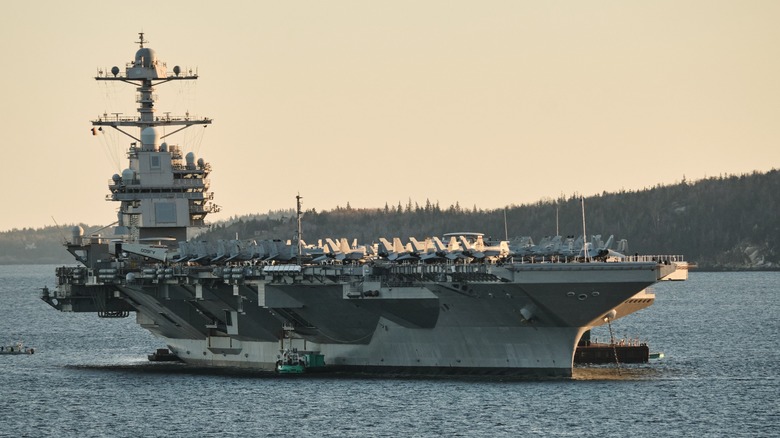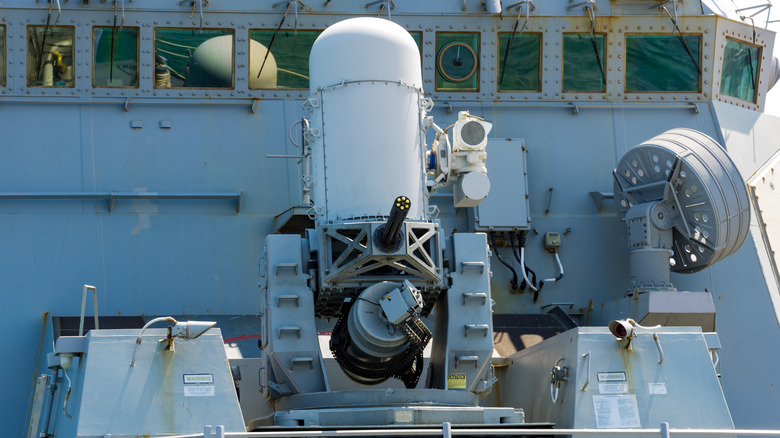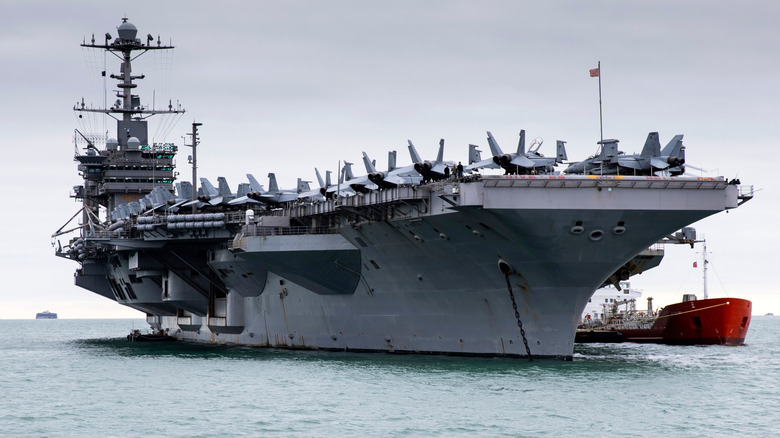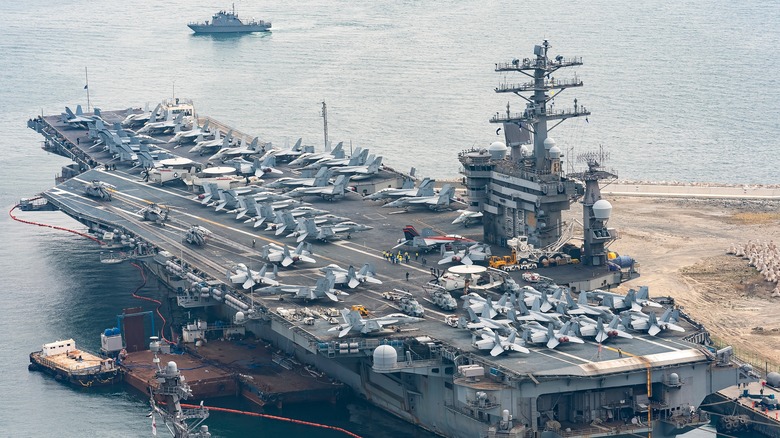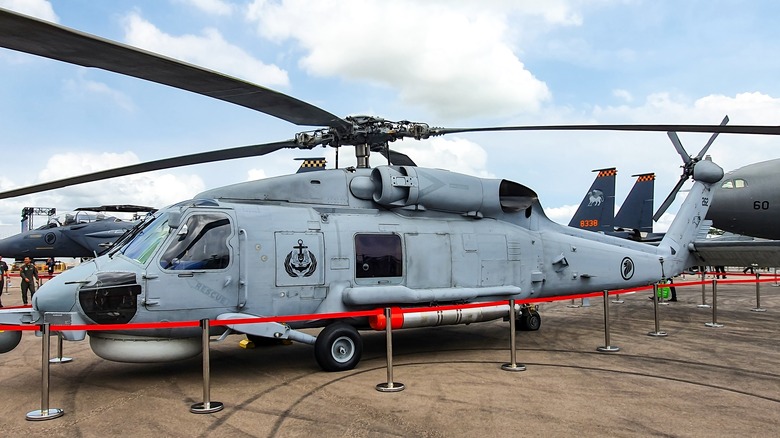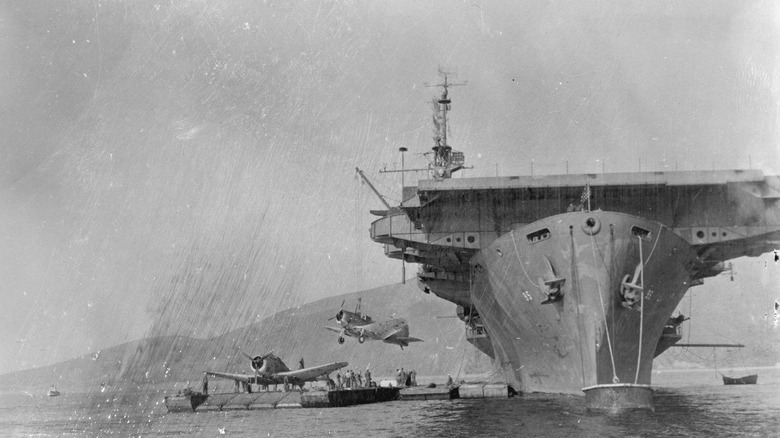Do US Aircraft Carriers Have Guns? Here's How They Defend Against Attacks
An aircraft carrier is a vast ship (the world's largest aircraft carrier being over 1,100 feet long) that serves as a sort of mobile base for aircraft. They're friendly places to land, to refuel and supply, to rendezvous with other personnel, to provide a base of operations for attacks and a runway of sorts from which they can be launched. By virtue of their status as home for potent military aircraft, then, they have access to great firepower. In Britain, for instance, the Royal Navy's Queen Elizabeth class carrier can accommodate up to 36 F-35Bs and 72 planes overall, while the Nimitz-class carriers of the United States boast room for around 5,000 people and 60 aircraft.
While a full complement of such aircraft may not be available to respond to a given attack at a moment's notice, an aerial attack on one from other fighters or bombers would be particularly risky as a result. As the U.S. Navy's Lieutenant Commander John A. Collet put it back in 1942 (per the U.S. Naval Institute), an aircraft carrier, "with its defending fighter planes ... has a better defense than any other type of ship in existence. One good fighter plane squadron is worth more than all the anti-aircraft fire of an entire task force as an air defense."
The best defense is a good offense, as they say. This doesn't mean, though, that U.S. aircraft carriers lack any equipped guns of their own. Here's how they're defended.
The Phalanx CIWS system
Today's carriers may face direct threats from other aircraft, longer-range assaults from missiles, assaults from the ocean itself (submarines for instance), just as some of the possibilities. With the unpredictable range of dangers, they need to be equally multifaceted in the defenses they employ. The potent Phalanx CIWS (Close-In Weapon System) is one advanced method of doing just that, employed on the Nimitz-class carriers.
This sophisticated and versatile system has an important place in naval combat, with creator Raytheon explaining that it serves to "defeat anti-ship missiles and close-in threats that have pierced other lines of defense". It's a vulcan autocannon with advanced systems that allow it to track the position of incoming threats and fire lightning fast salvos to destroy them. The Phalanx is both an offensive and defensive weapon, a common trend among the equipment of these mighty ships.
The CIWS equipped on the USS George H.W. Bush, YouTube's Smithsonian Channel reports, is a 20mm cannon that "lives inside a swiveling base almost 15 feet high" and unleashes rounds that are "twice as big as the standard U.S. machine gun's." The weapon boasts a range of up to around five miles, affording it some further versatility in the attacks it can intercept. Aside from such a cannon, an aircraft carrier will also commonly be equipped with some advanced missiles, with the Sea Sparrow being one example.
The Sea Sparrow
While a sparrow may not be the most intimidating of birds to name a weapon for, the Sea Sparrow missile is another crucial element of some carriers' built-in weaponry. Found on aircraft carriers such as the USS Harry S. Truman, these weapons have a similar role to that of the CIWS system. They are not specifically intended for attack, but instead to intercept incoming dangers. Along with the nuclear-powered aircraft carriers that are the CVN ships, this missile is also equipped on LHA and LHD-class ships, both being amphibious assault vessels such as the Wasp class. The LHA and LHD ships share the carriers' qualities of being big, strategically valuable targets, so it stands to reason that similarly potent defenses would be equipped on them too.
General Dynamics joined Phalanx developer Raytheon in adapting the original Sea Sparrow into the surface-to-air form employed by these ships. Derived from the basic point-defense missile system concept that was halted in 1964, it retained the primary use envisioned by the program: to provide a close-range defense against missiles by meeting them with another missile. The AIM-7F Sea Sparrow sports semi-active homing capacity by means of a radar connection, with a dual-thrust engine and sophisticated radar allowing it to keep pace with threats. The weakness again, though, is that the system was designed for shorter-ranged operation.
Safety in numbers is a huge part of protecting aircraft carriers
Just as a bomber would be tremendously vulnerable to opposing fighters if venturing alone, so aircraft characters are also rather reliant on traveling with allied craft as well. This is where carrier battle groups come in. This arrangement involves multiple craft in formation, with different types of ship each equipped to manage a particular danger better than a lone aircraft carrier itself would. Accompanied by friendly vessels above and below the waves, carriers can operate more freely.
Any plan to attack a carrier will be met by far more than just the vessel or its aircraft themselves. As the U.S. Navy reports, "the Navy maintains 11 carrier strike groups, 10 of which are based in the United States and one that is forward deployed in Japan. CSG or CVBG normally consist of 1 Aircraft Carrier, 2 Guided Missile Cruisers, 2 Anti Aircraft Warships, and 1-2 Anti Submarine Destroyers or Frigates."
The mere fact that there are less than a dozen of these strike groups in the U.S. Navy indicates how precious and rare aircraft carriers can be, thereby warranting such heavy protection. At the same time, though, they are strategic bases of great importance. As such, the remote distances at which they are often based, and the sheer difficulty of locating them, become a factor in defense, too.
Tailored defenses against specific threats
Historically, one of the most fearsome enemies of aircraft carriers has been the submarine. The combined stealth and firepower of a submarine can allow them to devastate ships many times their own size, and often in relative safety to boot. It has long been critical, then, that aircraft carriers take steps to defend themselves. Thankfully, the ships that accompany carriers can be customized to meet specific threats that may be expected.
To shore up the fleet's weaknesses against submarines, some carriers have been reassigned to address the threat specifically. In March of 1960, Essex IV was one model adapted to an anti-submarine warfare support carrier. In such a configuration, the aircraft serving with the model are those dedicated to dispatching the lingering threat of subs, such as helicopters.
Models such as the S-70B Seahawk, armed with sophisticated sonar along with penguin missiles, EuroTorp A244 torpedos and other armaments, remain some of the very best friends an aircraft carrier threatened by submarines could ever have. This further emphasizes the point that a carrier's most effective weapons are typically those equipped by the very aircraft it carries.
The remarkably attack-resistant design of an aircraft carrier
The size and unique design of an aircraft carrier are significant defensive assets, as shown in the case of the USS America. This mighty Kitty Hawk class aircraft carrier was sunk in 2005, but not as a result of hostile action: The navy used the vessel as an exercise to see just how much it took to destroy a cruiser.
The navy wanted to gather information on the effect of different weaponry on the hull of a carrier. Those hulls, however, are protected from direct assault by more than armor. Multiple layers are utilized in their design (as seen on the USS Nimitz class), a brilliant compartmentalization that mitigates the devastation of a potential impact, making the enormous ship far more difficult to sink by reducing the chance of flooding them.
Everything the navy threw at its own ship initially failed. Unable to sink it through direct assaults (imitating the effects of opposing missile and torpedo strikes) and after around a month of trying, it was necessary to come aboard the carrier and scuttle it from there. Ultimately, only strategically-placed explosives, which compromised that layered hull and allowed it to be breached by the water, did the job. It just goes to show how resilient a carrier is. With all of this in mind, it isn't surprising that an aircraft carrier hasn't been sunk during combat since the USS Bismarck Sea, which was lost in February 1945 in battle against Japanese forces.
